New York City Ballet's Spring Season
For Lincoln: 10 Modern Classics
"It's not only that there is no Balanchine today, you know. It's that there is no Kirstein." — George Jackson
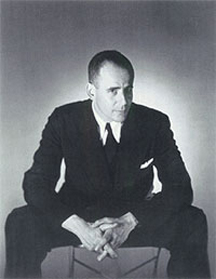
Program One
reviewed by Gay Morris
Program Two
reviewed by Michael Popkin
Program Three
reviewed by Tom Phillips
Programs Four and Five
reviewed by Leigh Witchel
Royal Ballet
“The Seven Deadly Sins”, “Pierrot Lunaire”, “La Fin du Jour”
by John Percival
 This must be the worst programme the Royal Ballet has given for many years. First of all, the new work that began it, Will Tuckett's disastrous staging of “The Seven Deadly Sins”, gets us into a state of gloom. But the sadly thin revival of “La Fin du Jour” that ends the show doesn't do anything to make amends. Kenneth MacMillan created this ballet in 1979 to Ravel's second piano concerto. The stage is congested with the stylised gaping faces that make up Ian Spurling's decor, peering in from the sides and hanging from above. In what are alleged to be 1930s costumes two women, two men and a supporting group jiggle around, in beachwear, ball dresses or aviators' gear. The work was never a great hit even with the original cast of leading dancers under the choreographer's eye, and this restaging, with replacement leads and perhaps with limited rehearsal time, is unlikely to change that. Natasha Oughtred has lovely legs and looks extremely pretty, but that's not enough. READ MORE
This must be the worst programme the Royal Ballet has given for many years. First of all, the new work that began it, Will Tuckett's disastrous staging of “The Seven Deadly Sins”, gets us into a state of gloom. But the sadly thin revival of “La Fin du Jour” that ends the show doesn't do anything to make amends. Kenneth MacMillan created this ballet in 1979 to Ravel's second piano concerto. The stage is congested with the stylised gaping faces that make up Ian Spurling's decor, peering in from the sides and hanging from above. In what are alleged to be 1930s costumes two women, two men and a supporting group jiggle around, in beachwear, ball dresses or aviators' gear. The work was never a great hit even with the original cast of leading dancers under the choreographer's eye, and this restaging, with replacement leads and perhaps with limited rehearsal time, is unlikely to change that. Natasha Oughtred has lovely legs and looks extremely pretty, but that's not enough. READ MORE
The Nothing Festival
by Lisa Rinehart
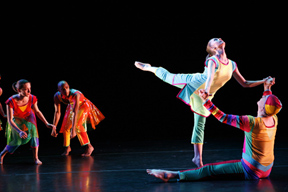 Happily, DTW's "Nothing Festival," curated by Tere O'Connor, doesn't live up to its name — at least, not in obvious ways. O'Connor's premise for the festival is to give a selection of dance artists the opportunity to create work without the "marketing, fundraising, and production challenges that seem to overshadow the process of making a dance. No proposals, no explanations, these choreographers must only begin." In other words, carte blanche for eight artists who could probably blanket DTW's stage with the paperwork generated from years of semi-dignified pleas for money, space, permission, and respect. What makes this nothing fest something, however, is O'Connor's nose for dance theater that is obscure, emotional and almost never boring. Some of the work is less than polished, but both evenings are remarkably short on pretension. Ironically, O'Connor's framework of "no story, no music, and no outside source," appears to have restricted self referential wallowing — or perhaps O'Connor just knows how to pick 'em. READ MORE
Happily, DTW's "Nothing Festival," curated by Tere O'Connor, doesn't live up to its name — at least, not in obvious ways. O'Connor's premise for the festival is to give a selection of dance artists the opportunity to create work without the "marketing, fundraising, and production challenges that seem to overshadow the process of making a dance. No proposals, no explanations, these choreographers must only begin." In other words, carte blanche for eight artists who could probably blanket DTW's stage with the paperwork generated from years of semi-dignified pleas for money, space, permission, and respect. What makes this nothing fest something, however, is O'Connor's nose for dance theater that is obscure, emotional and almost never boring. Some of the work is less than polished, but both evenings are remarkably short on pretension. Ironically, O'Connor's framework of "no story, no music, and no outside source," appears to have restricted self referential wallowing — or perhaps O'Connor just knows how to pick 'em. READ MORE
Royal Danish Ballet mixed bill
by Eva Kistrup
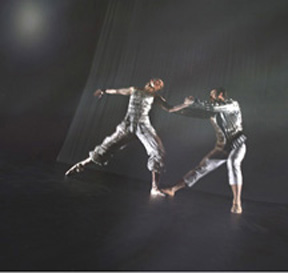 When Alvin Ailey choreographed the otherwise unmemorable “Caverna Magica” for the Royal Danish Ballet, he felt inspired to create an additional solo piece for Copenhagen ballerina Mette Hønningen, called “Witness”, a gospel piece in the style of “Cry”. Ailey was fascinated by the beautiful Danish ballerina, groomed for the classic parts by Vera Volkova and with a strong gift for modern ballet as well — a gift that was used by guest modern choreographers like Ailey, Glen Tetley and Choo San Goh, who all choreographed for the then-mature ballerina. Since retirement Mette Hønningen has not often been used as a coach by the company, which is a great loss because as the last ballerina totally developed by Vera Volkova and a strong dramatic artist in her own right, she could have been a valuable continuing inspiration and guide for the next generations. For an American audience she is probably best known from the Disney film “The Ballerina”. READ MORE
When Alvin Ailey choreographed the otherwise unmemorable “Caverna Magica” for the Royal Danish Ballet, he felt inspired to create an additional solo piece for Copenhagen ballerina Mette Hønningen, called “Witness”, a gospel piece in the style of “Cry”. Ailey was fascinated by the beautiful Danish ballerina, groomed for the classic parts by Vera Volkova and with a strong gift for modern ballet as well — a gift that was used by guest modern choreographers like Ailey, Glen Tetley and Choo San Goh, who all choreographed for the then-mature ballerina. Since retirement Mette Hønningen has not often been used as a coach by the company, which is a great loss because as the last ballerina totally developed by Vera Volkova and a strong dramatic artist in her own right, she could have been a valuable continuing inspiration and guide for the next generations. For an American audience she is probably best known from the Disney film “The Ballerina”. READ MORE
San Francisco Letter 27
Paul Taylor, Navarrete x Kajiyama Dance Theater
by Rita Felciano
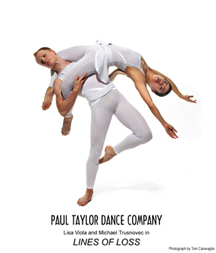 Last month, San Francisco Performances, the city’s pre-eminent 22 year-old performing arts organization, ended a noble experiment. For the last five years, hoping to increase and broaden its subscriber basis without which no independent presenter can survive, it annually presented the Paul Taylor Dance Company. On the schedule were three different programs with two performances each. Sometimes a family matinee was included. While San Francisco Performances had presented the Taylor company periodically since 1990, this was an exceptional artistic and financial commitment to Taylor and his work. Included in the line-ups were some of Taylor’s most popular evergreens—“Arden Court”, “Aureole”-- at least one world premiere, “Dante Variations”, but also less familiar works from the 70’s like “Book of Beasts,” “Runes,” “Images” and “Dust.” The earliest choreographies dated back to the 1962 “Piece Period” and “From Sea to Shiny Sea” from 1965. READ MORE
Last month, San Francisco Performances, the city’s pre-eminent 22 year-old performing arts organization, ended a noble experiment. For the last five years, hoping to increase and broaden its subscriber basis without which no independent presenter can survive, it annually presented the Paul Taylor Dance Company. On the schedule were three different programs with two performances each. Sometimes a family matinee was included. While San Francisco Performances had presented the Taylor company periodically since 1990, this was an exceptional artistic and financial commitment to Taylor and his work. Included in the line-ups were some of Taylor’s most popular evergreens—“Arden Court”, “Aureole”-- at least one world premiere, “Dante Variations”, but also less familiar works from the 70’s like “Book of Beasts,” “Runes,” “Images” and “Dust.” The earliest choreographies dated back to the 1962 “Piece Period” and “From Sea to Shiny Sea” from 1965. READ MORE
ABT Studio Company
by Mary Cargill
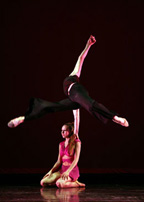 ABT's Studio Coompay, the 13-member group of young dancers now led by its new artistic director Kirk Peterson, performed an intriguing mixture of new and old works, showcasing their considerable talents—if not always in first-rate choreography.
ABT's Studio Coompay, the 13-member group of young dancers now led by its new artistic director Kirk Peterson, performed an intriguing mixture of new and old works, showcasing their considerable talents—if not always in first-rate choreography.
The program opened with the New York premiere of Brian Reeder’s "Ghost Light," to music (not identified) of Aaron Copland. Reeder, in earlier works for the Studio Company, has shown a gift for characterization, and the new work, too, had a deft economy of gesture. A blank stage and a bare light bulb and a young man (Roddy Doble), with a mop combined with the slightly raucous nostalgia of the music, effortlessly evoked the backstage of a small vaudeville theater, populated by the ghosts of hoofers of yesteryear. Three couples danced variations of social dances, a flapper, a waltz, and a tap dance, and at the end, the stage hand sets down his mop (shades of Cinderella,) joins hands with the waltz girl, and goes off with the ghosts. It was a gentle and charming little fairy tale, which, though somewhat limited choreographically, suited the young dancers. READ MORE
Stephen Petronio Company
by Leigh Witchel
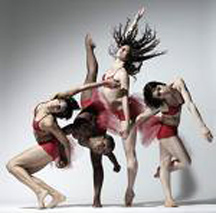 Stephen Petronio’s company is always fabulous, and that’s a compliment most of the time. Petronio understands fabulous; how to find it, how to acquire it and especially how to work it. His costumes, by Paul Compitus, Tara Subkoff/Imitation of Christ and H. Petal range from unitards with the most discreet shark’s fin at the nape of the neck to quasi-military beefcake soft-core porn, if Michael Badger’s magnificent six-pack abs can be considered a costume. The music Petronio uses, from gay underground cult singer Antony’s haunting and vulnerable vocals to Rufus Wainwright to the Beastie Boys, rarely condescends to slum with the bourgeoisie. The dancing and the gorgeous, loose limbed dancers are fabulous. If you just let it wash over you, the whole evening was pretty fabulous. But fabulous was the only dish on the menu and it’s not a varied diet.READ MORE
Stephen Petronio’s company is always fabulous, and that’s a compliment most of the time. Petronio understands fabulous; how to find it, how to acquire it and especially how to work it. His costumes, by Paul Compitus, Tara Subkoff/Imitation of Christ and H. Petal range from unitards with the most discreet shark’s fin at the nape of the neck to quasi-military beefcake soft-core porn, if Michael Badger’s magnificent six-pack abs can be considered a costume. The music Petronio uses, from gay underground cult singer Antony’s haunting and vulnerable vocals to Rufus Wainwright to the Beastie Boys, rarely condescends to slum with the bourgeoisie. The dancing and the gorgeous, loose limbed dancers are fabulous. If you just let it wash over you, the whole evening was pretty fabulous. But fabulous was the only dish on the menu and it’s not a varied diet.READ MORE